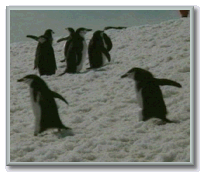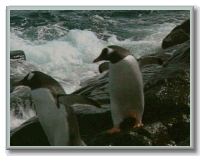While large congregations of birds are found ashore in the summer, large numbers of young, adolescent and non-breeding birds may also be observed throughout the Southern Ocean at any time, ranging widely in their search for food. Watching these birds at sea is one of the genuine pleasures of long sea voyages under strong winds and rough seas.
Compared with other continents, Antarctica has very few species of breeding birds. Even when the sub-Antarctic species are included, the total is just over 40 as compared with several thousand found collectively in Africa, South America and Australia. Although few species breed in the Antarctic region, the numbers of individuals are very large.
|
|
|
True terrestrial birds are not found on the Antarctic continent and only a few, including two species of duck, two sheathbills and a pipit, have successfully colonized some of the southern sub-Antarctic islands.
Sea-birds have been more successful than land birds in colonizing the Antarctic region because they have evolved, over long periods of time, adaptations for life bound to a marine environment. Particular features such as those which help conserve body heat (e.g. special waterproof plumage, an insulating layer of subcutaneous fat, large body size, compact form and a lack of bare skin), have enabled them to extend their range south to exploit the Southern Ocean and establish breeding colonies on the sub-Antarctic islands and the Antarctic continent.
|
|
WANT TO LEARN MORE?
|
|
|
Websites
• Antarctic petrel Information including taxonomy of the Antarctic petrel. • South polar skua Information on the South polar skua includes taxonomy information. • Southern giant-petrel Facts about the Southern giant-petrel including taxonomy. • Prehistory More background information on the prehistory of Antarctica. • Antarctic Adventure 1997 Information on the geography and climate of Antarctica. |
|
![]()

